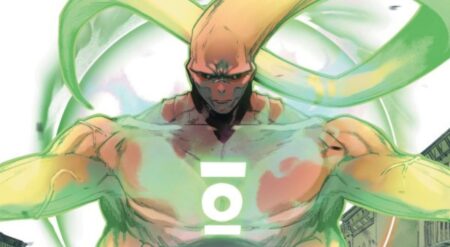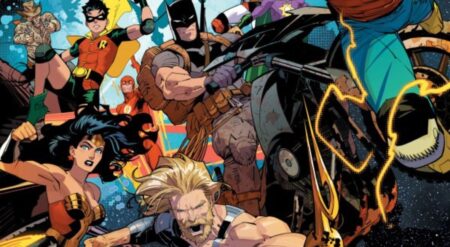Green Lantern #3 is published by DC Comics, written by Jeremy Adams, art by Xermánico, colors by Romulo Fajardo Jr., and letters by Dave Sharpe. Phillip Kennedy Johnson writes the backup story, with art by Montos, colors by Adriano Lucas, and letters by Sharpe. In one Green Lantern story, Sinestro starts his mission of revenge. In the other, in another universe, John Stewart and Guy Garnder face off against the Revent Queen.
There are two vastly different Green Lantern plots happening in this issue. On Earth, Hal’s adventure has the air of an origin story, learning the ropes of a troublesome and different ring than the one he’s used to. It has separate capabilities from a standard ring but also the possibility of cutting out on him. Green Lantern #3 is also an issue of preparation and transition. Hal’s actions in the book are largely reactive to what Sinestro is up to, as a new evil squad is being gathered for revenge. The book, and specifically this story, was interrupted by the events of Knight Terrors, but the ramifications of that crossover are minimal. Adams can pick up when the comic left off, but the pacing takes some time to establish itself. Sinestro’s plan is creepy, and his team is both alien with some Earth villains stitched in.
The other story concludes an epic space battle, the opposite of what is going on with Hal on Earth. John Stewart is the power battery and unfathomably powerful, unleashing the full force of his abilities. The universe-hopping nature of this second story is mind-boggling, but the battle itself carries with it the magnitude that wars involving Lanterns can contain. This half of the comic moves at a fast pace until the end of the battle, truly awesome in its execution. Where Hal seems to be telling a singular, smaller tale, what Johnson is exploring appears to affect much more within the Multiverse.
The characters are fascinating within the issue. The old trope suggests that a hero is nothing without their villain, and Sinestro is a magnificent opposite side of the coin to Hal. In both the Knight Terrors tie-in and first issues of this series, The former Green Lantern was presented as weak and destitute. But now he is making moves that are terrifying and true to his form. He’s a master manipulator, having numerous options for getting what he wants. Regaining his arrogance makes him even more terrifying.
Whilst that first story tries to establish the fear a character possesses, the other looks at one in awe. The alternate universe’s version of Hal looks at that all-powerful, omniscient incarnation of John with a sense of pride and bewilderment, presenting the being as this messianic figure. It hero-worships him with an acquiescence that has rarely been seen before in this issue. The narration is stunning, so respectful and enamored. There are actually two versions of the Lanterns due to the Multiversal trickery, allowing for two heartfelt conversations on both worlds.
The art is extraordinary in both stories. Xermánico’s style is beautifully clean and clear, using both space and immaculate details for when either is needed. Hal’s costume has a simple brilliance, whereas some of the alien designs deserve more intricate ideas. The locations, especially Coast City, are jaw-dropping in scale. Adams is enjoying blending the cosmic chaos with the normality of North America, and Xermánico is mixing the two well. The powers and constructs are encroaching on the natural world.
In contrast, there is an unrelenting wave of constructs and madness. This version of John Stewart is remarkably powerful, conjuring up whole armies to unleash on the Revenant Queen. Montos superbly generates these figures, making them haunting as they look like a legion of ghosts. John Stewart looks amazing, considerably different from any other iteration of the character. He has transcended into a new form, presented as something close to a god, with an aura that represents that new power.
The colors are terrific. The opening scene of the comic is extremely fun, and part of that is playing around with shades and colors. The green of Hal’s costume is not as vibrant as it has been in previous years, but it’s more fitting within a more natural and grounded world. The opposite happens in the second story, where the luminescence is supposed to be a symbol of power. The lettering is distinct and clear at all times within the issue.
Green Lantern #3 returns to its regular storytelling. After the Knight Terrors distraction, the book seamlessly transitions into Sinestro’s revenge and Hal’s attempt to figure out his new ring. Both tales detail the spectrum of what can appear in a Green Lantern comic. One is cosmic and huge whilst the other feels like a traditional superhero adventure. It has taken two of the most important figures with the Lantern mythos and grounded them.
Green Lantern #3 is available where comics are sold.
Green Lantern #3
TL;DR
Green Lantern #3 returns to its regular storytelling. After the Knight Terrors distraction, the book seamlessly transitions into Sinestro’s revenge and Hal’s attempt to figure out his new ring.







